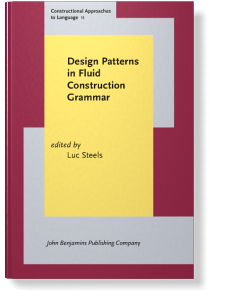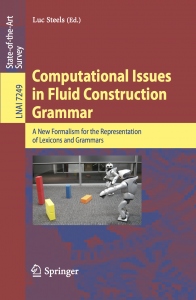The FCG Cookbook (working title, manuscript in preparation)
Fluid Construction Grammar is a computational platform that provides linguists with the necessary building blocks for implementing construction grammars. The FCG representations and tools have been changing rapidly over the last five years, resulting in a powerful open source code base that has been receiving much attention lately. The FCG Cookbook is the first collection of how-to recipes that aims to pass on common practices and solutions dealing with implementing construction grammar analyses, evolutionary linguistics experiments and language technology applications.
- Pre-publications of a limited number of recipes are available here.
Design Patterns in Fluid Construction Grammar
Construction Grammar is enthusiastically embraced by a growing group of linguists who find it a natural way to formulate their analyses. But so far there is no widespread formalization of construction grammar with a solid computational implementation. Fluid Construction Grammar attempts to fill this gap. It is a fully operational computational framework capturing many key concepts in construction grammar. The present book is the first extensive publication describing this framework. In addition to general introductions, it gives a number of concrete examples through a series of linguistically challenging case studies, including phrase structure, case grammar, and modality. The book is suited both for linguists who want to know what Fluid Construction Grammar looks like and for computational linguists who may want to use this computational framework for their own experiments or applications.
- Click here for demonstrations and samples of the book.
Computational Issues in Fluid Construction Grammar
This state-of-the-art-survey documents the Fluid Construction Grammar (FCG), a new formalism for the representation of lexicons and grammars, which has been used in a wide range of case studies for different languages, both for studying specific grammatical phenomena and design patterns, as for investigating language learning and language evolution. The book focuses on the many complex computational issues that arise when writing challenging real world grammars and hence emphasises depth of analysis rather than broad scope. The volume contains 13 contributions organized in 5 parts from “Basic”, and “Implementation”, over “Case Studies”, and “Formal Analysis”, up to 3 papers presenting a “Conclusion”.
- Click here for demonstrations and samples of the book.

